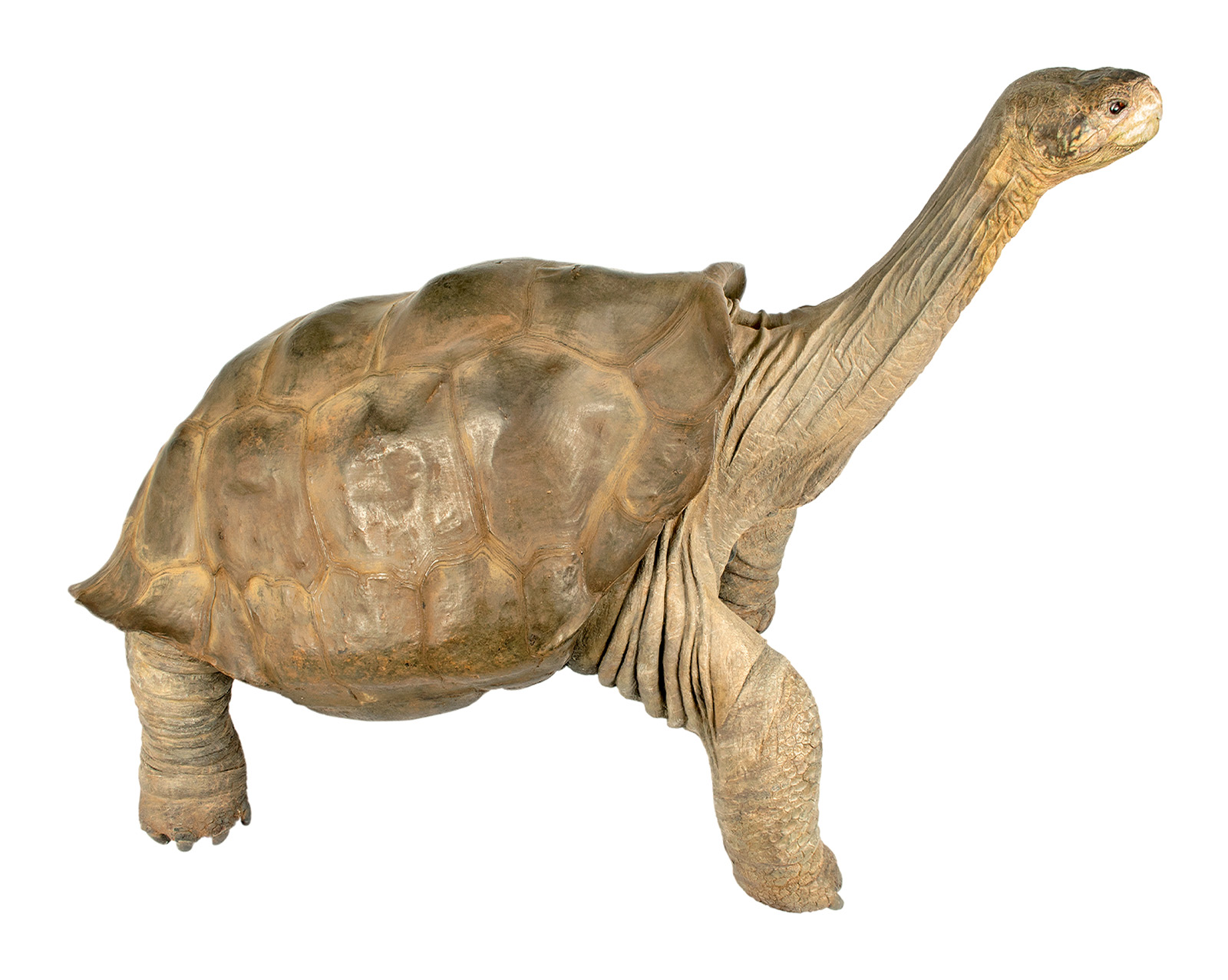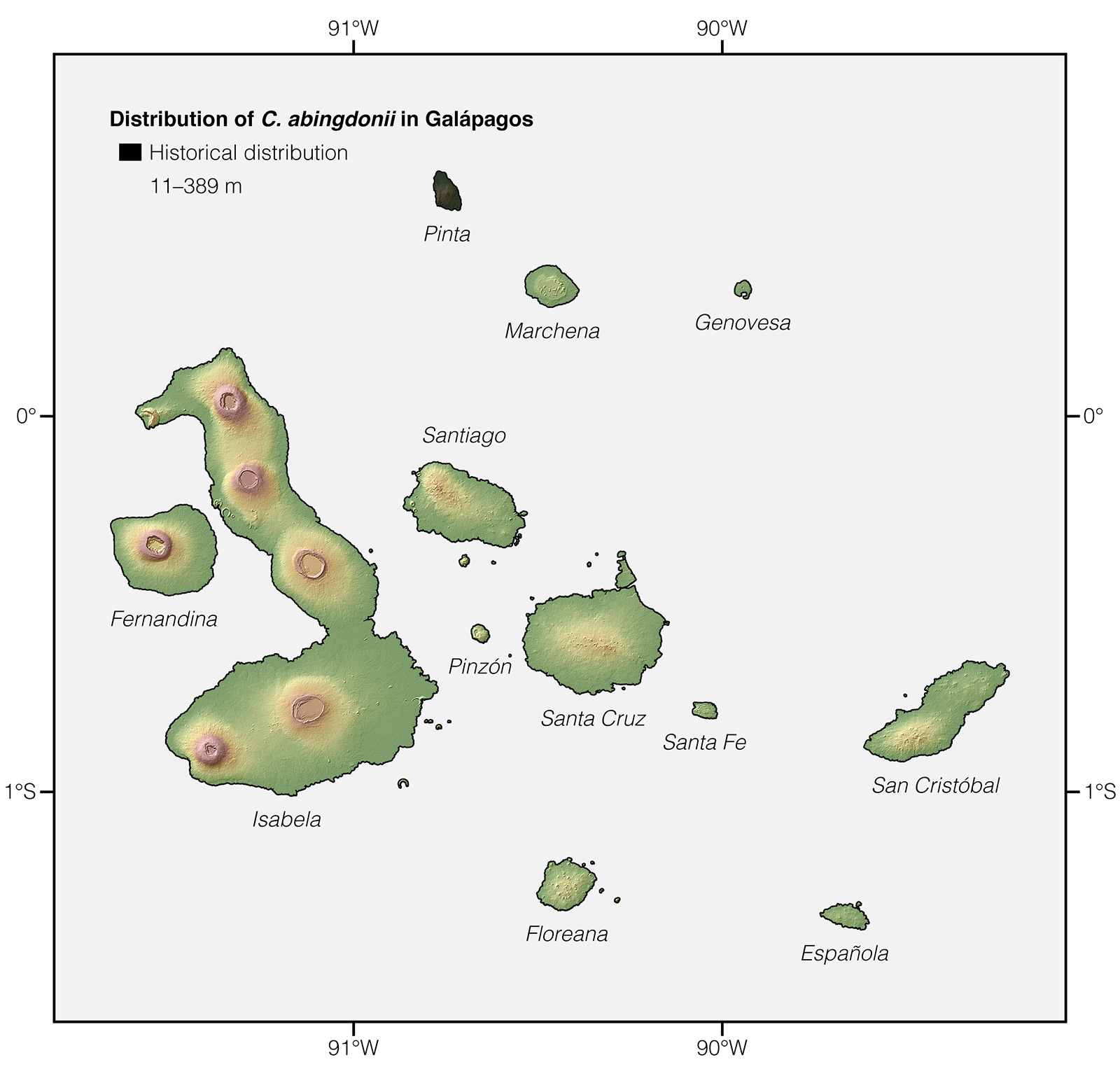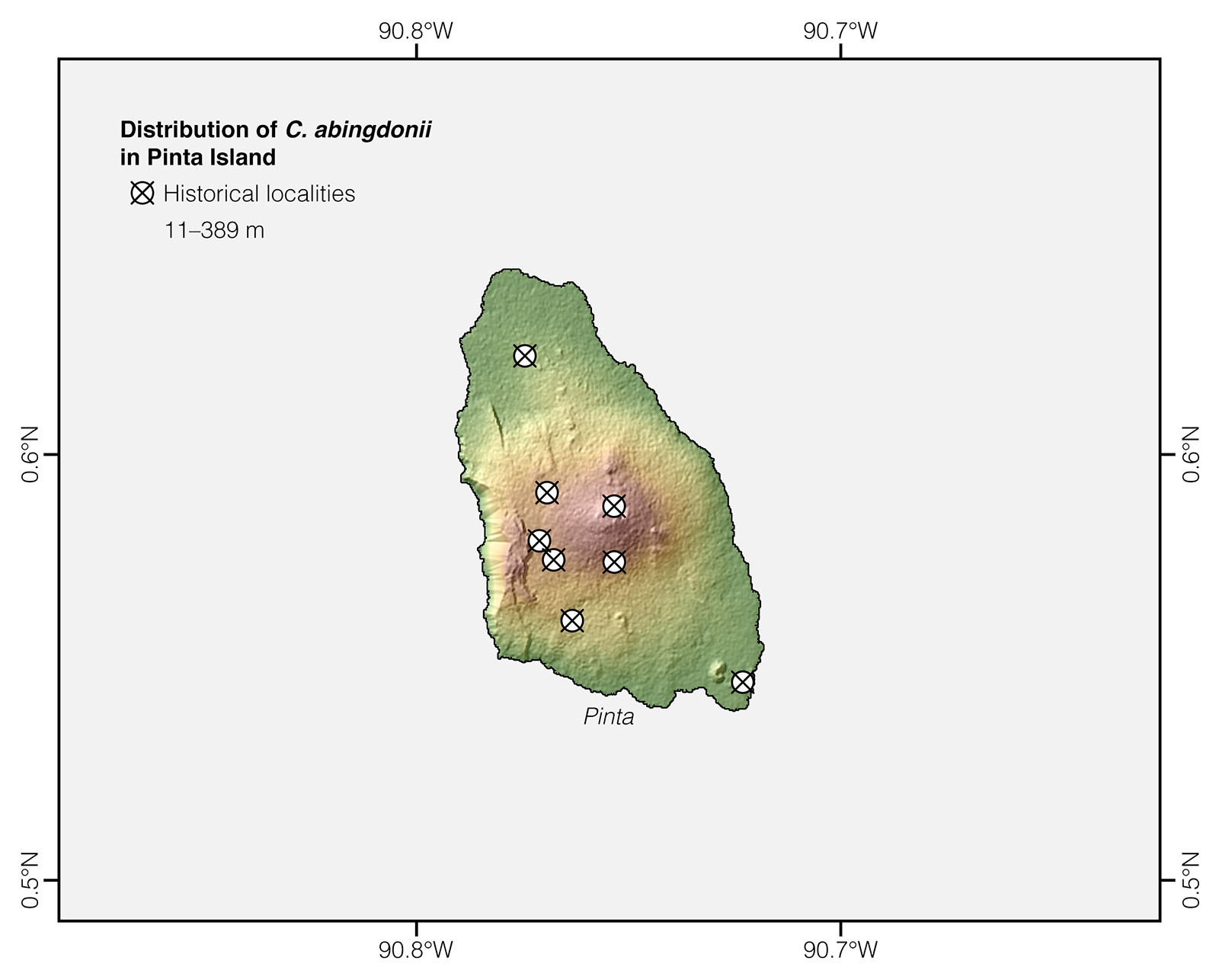Pinta Giant-Tortoise |
Reptiles of Ecuador | Testudines | Testudinidae | Chelonoidis abingdonii
English common names: Pinta Giant-Tortoise, Abingdon Island Giant-Tortoise.
Spanish common names: Galápago de Pinta, tortuga gigante de Pinta.
Recognition: ♂♂ 97.8 cm. Chelonoidis abingdonii was the only species of giant tortoise known to occur on Pinta Island. The carapace of this species has a distinctive saddleback shape.
Picture: Lonesome George, the last living individual of his species. He died on June 24, 2012. | |
 | |
Natural history: Common before the 1850s, but rare after that.1 Chelonoidis abingdonii was a diurnal and terrestrial tortoise that inhabited deciduous forests, evergreen montane forests, and humid grasslands. Wild Pinta Giant-Tortoises fed on low-hanging cactus pads.2 In captivity, Lonesome George fed on leaves of elephant ear plants and coral beans, both of which are cultivated introduced plants.3 Juveniles of C. abingdonii stayed in the warmer lowland areas of Pinta Island for their first 10–15 years.4 As adults, they roamed all the way up to the lush highlands.5
Between 1831 and 1868, 455 tortoises were taken from Pinta Island by whalers.
Charles Townsend, zoologist at the New York Aquarium, 1925.1
Conservation: Extinct.2 Chelonoidis abingdonii is listed in this category because the last known individual of the species, known as Lonesome George, in captivity since 1972, died in 2012.2 Despite extensive surveys, no other tortoises have been found on Pinta Island or in any of the world’s zoos.2 The Pinta Giant-Tortoise went extinct because of harvesting by whalers and other mariners6 and due to competition with introduced goats.7 However, tortoises with Chelonoidis abingdonii genes have been found on northern Isabela Island,8 nearby Banks Bay, a harbor where, hundreds of years ago, tortoises were thrown overboard by whalers and buccaneers when no longer needed. This represents an opportunity to bring back the extinct lineage of Lonesome George.8
"The irony is that these species have a second chance for the same reason that they died out: their handling by mariners some 200 years ago."
Adalgisa Caccone, researcher at Yale University, 2017.
Distribution: Chelonoidis abingdonii was historically endemic to Pinta, a 60 km2 island with a maximum elevation of 650 m. Galápagos, Ecuador.


Special thanks to Zrna Garic, our official protector of the Pinta Giant-Tortoise, for symbolically adopting this species and helping bring the Reptiles of Galápagos project to life.
Etymology: The generic name Chelonoidis comes from the Greek word chelone (meaning “tortoise”).9 The specific epithet abingdonii refers to the type locality,10 Pinta, previously known as Abingdon Island.
See it in the wild: Lonesome George, the last living individual of Chelonoidis abingdonii, died on June 24, 2012. He is now a taxidermy specimen on display at the Centro de Crianza Fausto Llerena on Santa Cruz Island, Galápagos.
FAQ
How do giant Galápagos tortoises mate? To mate, male giant tortoises get on top of the smaller females, immobilizing them with their weight, and inseminate them by inserting the lining their cloaca as though it was a "penis" into the female's cloaca. Copulation takes 10–20 minutes, and males produce resounding guttural sounds during the process.
How did tortoises arrive in Galápagos? It is though that tortoises arrived in Galápagos from mainland south America ~3 million years ago by drifting onboard vegetation rafts or simply by floating on their own.
How old can giant Galápagos tortoises get? Giant Galápagos tortoises are among the longest living animals. The record is 175 years for a tortoise of the species Chelonoidis porteri.
How old was Lonesome George when he died? Lonesome George was believed to be ~125 years (over a century!) old when he died.
What was tortoise oil used for? The oil of giant Galápagos tortoises was used as fuel to light street lamps in cities such as Quito and Guayaquil before the industries of petroleum and vegetable oils began to develop commercially.
Where is Lonesome George now? As of 2019, Lonesome George is now a taxidermy specimen on display the Centro de Crianza Fausto Llerena on Santa Cruz Island, Galápagos.
Authors: Alejandro ArteagaaAffiliation: Fundación Khamai, Reserva Arlequín, Ecoruta Paseo del Quinde km 56, Santa Rosa de Mindo, Pichincha 171202, Ecuador. and Juan M GuayasaminbAffiliation: Laboratorio de Biología Evolutiva, Universidad San Francisco de Quito (USFQ), Quito, Ecuador.,cAffiliation: Galapagos Science Center, Galápagos, Ecuador.,dAffiliation: Centro de Investigación de la Biodiversidad y Cambio Climático, Universidad Tecnológica Indoamérica, Quito, Ecuador.
Academic reviewers: Adalgisa Caccone.
Photographers: Jose VieiraaAffiliation: Tropical Herping (TH), Quito, Ecuador.,eAffiliation: ExSitu, Quito, Ecuador.
How to cite? Arteaga A, Guayasamin JM (2020) Chelonoidis abingdonii. In: Arteaga A, Bustamante L, Vieira J (Eds) Reptiles of Ecuador: Life in the middle of the world. Available from: www.reptilesofecuador.com
Literature cited:
- Townsend CH (1925) The Galápagos tortoises in their relation to the whaling industry: a study of old logbooks. Zoologica 4: 55–135.
- Cayot LJ, Gibbs JP, Tapia W, Caccone A (2016) Chelonoidis abingdonii. The IUCN Red List of threatened species. Available from: www.iucnredlist.org
- Field notes of Washington Tapia.
- Swingland IR (1989) Geochelone elephantopus. Galápagos giant tortoises. In: Swingland IR, Klemens MW (Eds) The conservation biology of tortoises. Occasional Papers of the IUCN Species Survival Commission (SSC), Gland, 24–28.
- Fritts TH, Fritts PR (1982) Race with extinction: herpetological notes of J. R. Slevin's journey to the Galápagos 1905–1906. Herpetological Monographs 1: 1–98.
- Pritchard PCH (1977) Three, two, one tortoise. Natural History Magazine 86: 90–100.
- Snow DW (1964) The giant tortoises of the Galápagos Islands: their present status and future chances. Oryx 7: 277–290.
- Edwards DL, Benavides E, Garrick RC, Gibbs JP, Russello MA, Dion KB, Hyseni C, Flanagan JP, Tapia W, Caccone A (2013) The genetic legacy of Lonesome George survives: Giant tortoises with Pinta Island ancestry identified in Galápagos. Biological Conservation 157: 225–228.
- Brown RW (1956) Composition of scientific words. Smithsonian Books, Washington, 882 pp.
- Günther AC (1877) The gigantic land-tortoises (living and extinct) in the collection of the British Museum. Order of the Trustees, London, 96 pp.